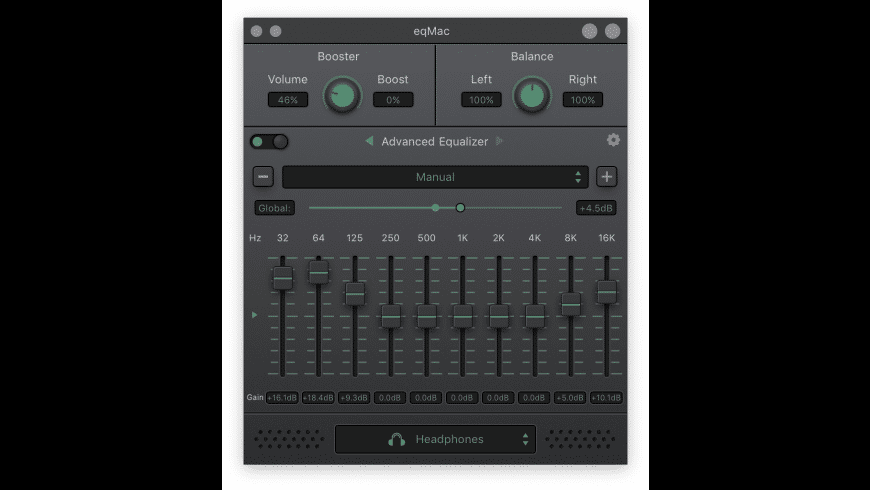- Audio Eq For Mac Download
- Audio Eq For Microsoft Edge
- Audio Eq For Mac Catalina
- Audio Eq For Mac Keyboard
It's designed to record audio from any source, including system audio. You do this by 'hijacking' the audio, and then recording. However, you can choose to simply hijack, and filter the audio, and not record. The app comes bundled with dozens of filters, and the one that works for me is the AudioUnit Effect Graphic EQ. Try the audio effector equalizer shortcut and you will benefit from it ever. Don't miss this app if you like music with a quick entrance to the equalizer and enhancements. In addition, with the help of an optional component, which works akin to the volume controls on your Mac, Boom 2 can effortlessly optimize any audio coming from your system on a system-wide basis with Equalizers and Audio Effects; for a crisper, clearer and a much better sounding experience.
Ever wish you had a system wide equalizer to adjust all audio output in Mac OS X and not just in iTunes? Maybe you want to adjust the way all audio output sounds or maybe you just want to boost the output volume of the built-in Mac speakers. We'll show you how to do both by creating your own universal EQ using two free tools, follow along:
Requirements
- Soundflower – free download from Google Code
- AU Lab – free download from Apple Developers (requires free Apple Dev ID)



Audio Eq For Mac Download
Download and install both Soundflower and AU Lab, you will then need to restart your Mac to have full access to the audio components. Once rebooted, follow along with the instructions below:
Set Up a Universal Audio Equalizer for Mac OS X
- Set System Volume to the maximum level, do this either through the menu bar or by hitting the Volume Up key repeatedly.
- Open System Preferences from the Apple menu and select the 'Sound' panel, followed by the 'Output' tab. Select 'Soundflower (2ch)' from the Output list.
- Now launch AU Lab, found in
/Applications/Utilities/. - From the 'Audio Input Device' pulldown menu, select 'Soundflower (2ch)', and then from 'Audio Output Device' menu select 'Stereo In/Stereo Out'.
- Click the 'Create Document' button at the bottom of the screen.
- At the next screen, look for 'Output 1' column and click the 'Effects' dropdown, selecting 'AUGraphicEQ'.
- This is your new system-wide equalizer, set it how you see fit. Changes here will impact all audio output on the Mac.
- When satisfied with the EQ settings, hit Cmd-S to save the EQ settings file and put it somewhere easy to find, like the Documents folder.
- Now open AU Lab preferences from the AU Lab menu, click on the 'Document' tab and click the radiobox next to 'Open a specific document', selecting the .trak EQ file you saved in the previous step.

Audio Eq For Microsoft Edge
Optional final step: If you want the EQ settings to load on every Mac OS X boot, right-click on the AU Lab icon, go to Options, and select 'Open at Login'.
It's important to note that AU Lab must be running in order for the equalizer to have an effect, keeping it running will consume a small amount of CPU resources but it's much less process hungry than some of the third party alternatives available on the market.
Parallel desktop 8 for mac free download. Sound Control 2.5.0 is a FREE upgrade for all owners of Sound Control.
Audio Eq For Mac Catalina
Version 2.5.0
Audio Eq For Mac Keyboard
- Devices menu now shows the Master Volume.
- Input devices now properly show and update the muted state.
- Toggle mute for default input device now shows the HUD to indicate status change.
- Add hotkeys for controlling the default input device’s gain and mute.
- Input devices now show gain dB value properly.
- Changing the gain of an input device no longer beeps.
- Added Priority devices for Input devices.
- Added HotKeys for changing the default input device.
- Volume feedback beeps now play on the appropriate device.
- Sound Control no longer interferes with macOS automatic device selection if priority devices are not enabled.
- Reduced CPU use.
- Added option to show and control apps that have been explicitly added to the listing.
- Fixed audio distortion after switching sample rates on bluetooth devices.
- Addressed application hang when switching to a bluetooth device or a built-in device on T2 Macs.
- Master volume displayed in the touch bar now updates properly when the default output device is changed.
- Added support for AirPlay!
- Added AppleScript support for setting mute, volume and balance.
- Added support for Zoom Thunderbolt audio devices.
- Sound Control volume change overlay more closely matches the system.
- Fixed a crash that could happen when muting AirPods Pro.
- Menu bar icon no longer shows disabled if STZ Audio Process plugin isn’t installed.
- Last version to support macOS 10.11 (El Capitan), 10.12 (Sierra), 10.13 (High Sierra. The next update to Sound Control will require macOS 10.14 (Mojave).
